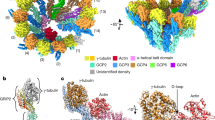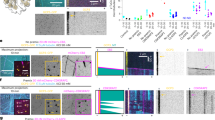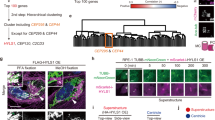Abstract
Microtubules are polymers of tubulin heterodimers that exhibit dynamic instability: periods of growth followed by periods of shrinkage1. However, the molecular regulation of dynamic instability remains elusive. Here, we show that EFA-6, a cortically-localized protein2, limits the growth of microtubules near the cell cortex of early embryonic cells from Caenorhabidits elegans, possibly by inducing microtubule catastrophes. Compared with wild type, embryos lacking EFA-6 had abnormally long and dense microtubules at the cell cortex, and growing microtubule plus ends resided at the cortex for up to five-fold longer. Loss of EFA-6 also caused excess centrosome separation and displacement towards the cell cortex early in mitosis, and subsequently a loss of anaphase spindle-pole oscillations and increased rates of spindle elongation. The centrosome separation phenotype was dependent on the motor protein dynein, suggesting a possible link between the modulation of microtubule dynamics at the cortex and dynein-dependent force production. EFA-6 orthologues activate ARF6-type GTPases to regulate vesicle trafficking3. However, we show that only the C. elegans EFA-6 amino-terminus is both necessary and sufficient to limit microtubule growth along the cortex, and that this function is independent of ARF-6.
This is a preview of subscription content, access via your institution
Access options
Subscribe to this journal
Receive 12 print issues and online access
$209.00 per year
only $17.42 per issue
Buy this article
- Purchase on Springer Link
- Instant access to full article PDF
Prices may be subject to local taxes which are calculated during checkout




Similar content being viewed by others
Accession codes
References
Mitchison, T. & Kirschner, M. Dynamic instability of microtubule growth. Nature 312, 237–242 (1984).
O'Rourke, S. M., Dorfman, M. D., Carter, J. C. & Bowerman, B. Dynein modifiers in C. elegans: light chains suppress conditional heavy chain mutants. PLoS Genet. 3, e128 (2007).
Franco, M. et al. EFA6, a sec7 domain-containing exchange factor for ARF6, coordinates membrane recycling and actin cytoskeleton organization. EMBO J. 18, 1480–1491 (1999).
Kozlowski, C., Srayko, M. & Nedelec, F. Cortical microtubule contacts position the spindle in C. elegans embryos. Cell 129, 499–510 (2007).
Siller, K. H. & Doe, C. Q. Spindle orientation during asymmetric cell division. Nat. Cell Biol. 11, 365–374 (2009).
Oegema, K. & Hyman, A. A. Cell division. WormBook, 1–40 (2006).
Dumont, S. & Mitchison, T. J. Force and length in the mitotic spindle. Curr. Biol. 19, R749–R761 (2009).
Grill, S. W., Howard, J., Schaffer, E., Stelzer, E. H. & Hyman, A. A. The distribution of active force generators controls mitotic spindle position. Science 301, 518–521 (2003).
Srayko, M., Kaya, A., Stamford, J. & Hyman, A. A. Identification and characterization of factors required for microtubule growth and nucleation in the early C. elegans embryo. Dev. Cell 9, 223–236 (2005).
Pecreaux, J. et al. Spindle oscillations during asymmetric cell division require a threshold number of active cortical force generators. Curr. Biol. 16, 2111–2122 (2006).
Severson, A. F. & Bowerman, B. Myosin and the PAR proteins polarize microfilament-dependent forces that shape and position mitotic spindles in Caenorhabditis elegans. J. Cell Biol. 161, 21–26 (2003).
Gönczy, P., Pichler, S., Kirkham, M. & Hyman, A. A. Cytoplasmic dynein is required for distinct aspects of MTOC positioning, including centrosome separation, in the one cell stage Caenorhabditis elegans embryo. J. Cell Biol. 147, 135–150 (1999).
Schmidt, D. J., Rose, D. J., Saxton, W. M. & Strome, S. Functional analysis of cytoplasmic dynein heavy chain in Caenorhabditis elegans with fast-acting temperature-sensitive mutations. Mol. Biol. Cell 16, 1200–1212 (2005).
Hamill, D. R., Severson, A. F., Carter, J. C. & Bowerman, B. Centrosome maturation and mitotic spindle assembly in C. elegans require SPD-5, a protein with multiple coiled-coil domains. Dev. Cell 3, 673–684 (2002).
Phillips, J. B., Lyczak, R., Ellis, G. C. & Bowerman, B. Roles for two partially redundant alpha-tubulins during mitosis in early Caenorhabditis elegans embryos. Cell Motil. Cytoskeleton 58, 112–126 (2004).
Hyman, A. A. & White, J. G. Determination of cell division axes in the early embryogenesis of Caenorhabditis elegans. J. Cell Biol. 105, 2123–2135 (1987).
Sammak, P. J. & Borisy, G. G. Direct observation of microtubule dynamics in living cells. Nature 332, 724–726 (1988).
Schulze, E. & Kirschner, M. New features of microtubule behaviour observed in vivo. Nature 334, 356–359 (1988).
Skop, A. R. & White, J. G. The dynactin complex is required for cleavage plane specification in early Caenorhabditis elegans embryos. Curr. Biol. 8, 1110–1116 (1998).
Gassmann, R. et al. A new mechanism controlling kinetochore-microtubule interactions revealed by comparison of two dynein-targeting components: SPDL-1 and the Rod/Zwilch/Zw10 complex. Genes Dev. 22, 2385–2399 (2008).
Macia, E. et al. The pleckstrin homology domain of the Arf6-specific exchange factor EFA6 localizes to the plasma membrane by interacting with phosphatidylinositol 4, 5-bisphosphate and F-actin. J. Biol. Chem. 283, 19836–19844 (2008).
Diogon, M. et al. The RhoGAP RGA-2 and LET-502/ROCK achieve a balance of actomyosin-dependent forces in C. elegans epidermis to control morphogenesis. Development 134, 2469–2479 (2007).
Portereiko, M. F. & Mango, S. E. Early morphogenesis of the Caenorhabditis elegans pharynx. Dev. Biol. 233, 482–494 (2001).
Janson, M. E., de Dood, M. E. & Dogterom, M. Dynamic instability of microtubules is regulated by force. J. Cell Biol. 161, 1029–1034 (2003).
Giaever, G. et al. Functional profiling of the Saccharomyces cerevisiae genome. Nature 418, 387–391 (2002).
Kamath, R. S. et al. Systematic functional analysis of the Caenorhabditis elegans genome using RNAi. Nature 421, 231–237 (2003).
Sönnichsen, B. et al. Full-genome RNAi profiling of early embryogenesis in Caenorhabditis elegans. Nature 434, 462–469 (2005).
Labbé, J. C., Pacquelet, A., Marty, T. & Gotta, M. A genome-wide screen for suppressors of par-2 uncovers potential regulators of PAR protein-dependent cell polarity in Caenorhabditis elegans. Genetics 174, 285–295 (2006).
Tong, A. H. et al. Systematic genetic analysis with ordered arrays of yeast deletion mutants. Science 294, 2364–2368 (2001).
Dorfman, M., Gomes, J. E., O'Rourke, S. & Bowerman, B. Using RNA interference to identify specific modifiers of a temperature-sensitive, embryonic-lethal mutation in the Caenorhabditis elegans ubiquitin-like Nedd8 protein modification pathway E1-activating gene rfl-1. Genetics 182, 1035–1049 (2009).
Park, D., Park, J., Park, S. G., Park, T. & Choi, S. S. Analysis of human disease genes in the context of gene essentiality. Genomics 92, 414–418 (2008).
Brenner, S. The genetics of Caenorhabditis elegans. Genetics 77, 71–94 (1974).
Oegema, K., Desai, A., Rybina, S., Kirkham, M. & Hyman, A. A. Functional analysis of kinetochore assembly in Caenorhabditis elegans. J. Cell Biol. 153, 1209–1226 (2001).
Strome, S. et al. Spindle dynamics and the role of γ-tubulin in early Caenorhabditis elegans embryos. Mol. Biol. Cell 12, 1751–1764 (2001).
McNally, K., Audhya, A., Oegema, K. & McNally, F. J. Katanin controls mitotic and meiotic spindle length. J. Cell Biol. 175, 881–891 (2006).
Praitis, V., Casey, E., Collar, D. & Austin, J. Creation of low-copy integrated transgenic lines in Caenorhabditis elegans. Genetics 157, 1217–1226 (2001).
Fraser, A. G. et al. Functional genomic analysis of C. elegans chromosome I by systematic RNA interference. Nature 408, 325–330 (2000).
Warming, S., Costantino, N., Court, D. L., Jenkins, N. A. & Copeland, N. G. Simple and highly efficient BAC recombineering using galK selection. Nucleic Acids Res. 33, e36 (2005).
Cheeseman, I. M. et al. A conserved protein network controls assembly of the outer kinetochore and its ability to sustain tension. Genes Dev. 18, 2255–2268 (2004).
Sarov, M. et al. A recombineering pipeline for functional genomics applied to Caenorhabditis elegans. Nat. Methods 3, 839–844 (2006).
Acknowledgements
We thank M. Price, G. von Dassow, L. Pelletier, and C. Doe for insightful discussions; M. Goulding and E. Munro for technical advice; S. Schneider for advice on taxonomical and sequence alignments; S. Mitani for isolating and providing efa-6(tm3124); V. Davis Haug for the mC-TBA-1 strain; and C. Doe and C. Cabernard for comments on the manuscript. S.M.O was supported by the Leukemia and Lymphoma Society of America, S.M.O. and B.B. are supported by NIH R01GM058017 and R01GMO49869.
Author information
Authors and Affiliations
Contributions
S.M.O. and B.B. designed the experiments and wrote the paper. S.M.O. conceived the project, performed the experiments and analysed the data. Microscopy and strain generation were also contributed by S.N.C.
Corresponding authors
Ethics declarations
Competing interests
The authors declare no competing financial interests.
Supplementary information
Supplementary Information
Supplementary Information (PDF 1677 kb)
Supplementary Movie 1
Supplementary Information (MOV 3453 kb)
Supplementary Movie 2
Supplementary Information (MOV 1554 kb)
Supplementary Movie 3
Supplementary Information (MOV 2919 kb)
Supplementary Movie 4
Supplementary Information (MOV 2093 kb)
Supplementary Movie 5
Supplementary Information (MOV 8655 kb)
Supplementary Movie 6
Supplementary Information (MOV 6129 kb)
Supplementary Movie 7
Supplementary Information (MOV 1341 kb)
Rights and permissions
About this article
Cite this article
O'Rourke, S., Christensen, S. & Bowerman, B. Caenorhabditis elegans EFA-6 limits microtubule growth at the cell cortex. Nat Cell Biol 12, 1235–1241 (2010). https://doi.org/10.1038/ncb2128
Received:
Accepted:
Published:
Issue Date:
DOI: https://doi.org/10.1038/ncb2128
This article is cited by
-
UNC-16/JIP3 and UNC-76/FEZ1 limit the density of mitochondria in C. elegans neurons by maintaining the balance of anterograde and retrograde mitochondrial transport
Scientific Reports (2018)
-
Kif2 localizes to a subdomain of cortical endoplasmic reticulum that drives asymmetric spindle position
Nature Communications (2017)
-
Direct interaction between centralspindlin and PRC1 reinforces mechanical resilience of the central spindle
Nature Communications (2015)
-
The DLK signalling pathway—a double‐edged sword in neural development and regeneration
EMBO reports (2013)
-
ARF family G proteins and their regulators: roles in membrane transport, development and disease
Nature Reviews Molecular Cell Biology (2011)



